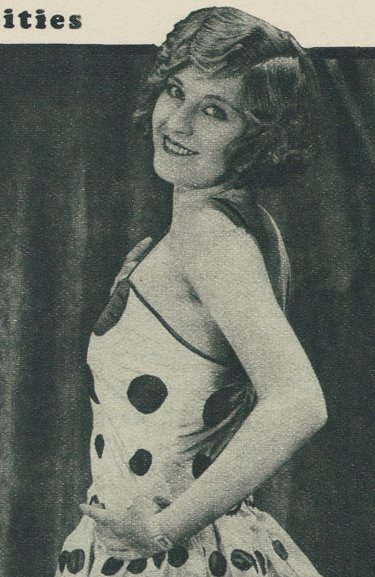
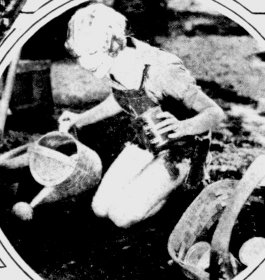
Researching Dolores Brinkman drove me nuts — she was beautiful, funny, mysterious and missing. We find something fascinating about fame that shies away from the public eye. To this day people name Greta Garbo as one of the greatest screen presences of all time, and yet she is more famous for her absence than for any one of her movies. Allow me to introduce Miss Dolores Brinkman, an MGM starlet in the 1920s who I spied in a newspaper clipping planting a tinned-pork-and-beans tree in her backyard. Brinkman was a teenage actress in half a dozen movies throughout the 1920s, but come 1930 Brinkman made her final picture and then simply… disappeared.
You’re unlikely to know Dolores Brinkman. She didn’t perform for long, and you have precious little chance of seeing any of the films she did make. Huge swathes of early films have not survived to the present day thanks to negligent archiving procedures and the volatile nature of early film stock. The bulk of Brinkman’s screen work is amongst these lost films. Of the nine1 films she appeared in, only two have survived. These are the early science-fiction flick The Mysterious Island (1929) and the short comedy Whispering Whoopee (1930).
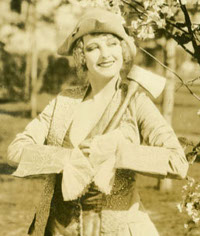
The best of Dolores Brinkman will always be her photo shoots. These photographs were shot to publicize an up-coming movie or simply to garner the actresses (and the studio) more attention. These are what reveal Dolores’ beauty and comic talent far more than her patchy film career. In one photograph she dresses up as George Washington cutting down a cherry tree and proclaiming, “I cannot tell a lie! I did it with my little hatchet.” Other photo shoots have her frolicking on the beach, dressing as Cupid or posing as an errant schoolboy.
However often this enigmatic beauty was photographed, she was rarely interviewed. Throughout the ’20s she remained a minor player for MGM, never saying much except for light-hearted sound bites and advice about hair. Her surviving films do little to showcase Brinkman herself; she has only a minor role in Mysterious Island and, despite having more face-time (and her only speaking role) in Whispering Whoopee, she doesn’t do much except stand around looking stroppy. Outside of her film and photo credits, Brinkman’s only other visible achievement from this time was being the first person to drive across the new Glendale-Hyperion Bridge in 19282. Then, in 1930 and without so much as a word to the media, Dolores Brinkman disappeared from the public eye.
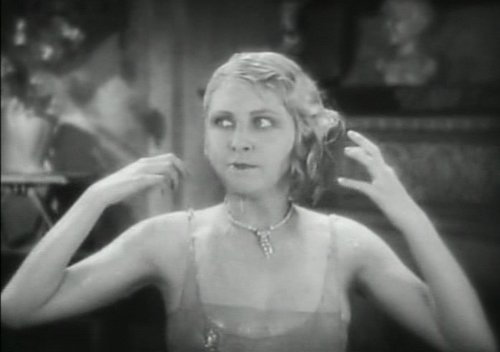
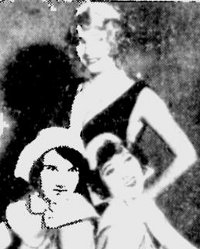
Dolores Vivian Brinkman was born in St. Louis on the 30th of July 1910 to parents Frank Brinkman and Viola Roberts. They were a working class family of German extraction, but evidently had their sights set on something higher. Sometime between 1920 and 1924 the family pulled up roots and moved to Los Angeles where Dolores would begin her film career3. I cannot say whether they moved in order to promote Dolores as a performer, but it seems likely. Dolores had studied dance from an early age and her earliest film roles were as dancers and chorus girls. I cannot imagine the 13-year-old simply stumbling into film roles without a little parental help.
Brinkman’s big break came in 1927 when she was cast as a faceless background dancer in The Big City (1928). While performing in the chorus, three girls — Dolores Brinkman, Betty Egan and Della Peterson — were discovered and cast in more prominent parts. “Tod Browning, director, picked them for a movie ballet, because of their knees, and their acting has won them principal roles since”4. The three girls apparently caused such a sensation when they turned up to film the chorus that the casting office ordered screen tests at once. Brinkman and Egan were promoted to principal roles in The Big City, while Peterson was cast in a different movie, The Latest From Paris5.
It took a lot of digging to find her again. I had no clue as to whether she had died, retired, changed her name or got married. In my fantasies she must have retired from the movie business for some exciting personal reason, some secret that was worth keeping for 80 years. Whenever I investigate a mystery like this, I feel like the bad guy who goes around sticking pins in children’s balloons. But if that’s the case, I only do it because I keep hoping to find a balloon that won’t burst.
In 1928 Dolores Brinkman married a film producer called Jerry B. Fairbanks, and by 1934 she had retired to her Los Angeles home as a housewife. We do not know why. She could easily have continued her film career, especially with a producer for a husband. Family life did not force her into retirement because her only child, daughter Jeralyn, was not born until 1941. I can only speculate that Fairbanks preferred her not to work, or that perhaps she had not enjoyed her time with MGM. It’s not unreasonable to suppose her film career was pushed on her by her parents, who trained her from a young age and helped her nab her earliest roles.
![Wins Decree - Mrs. Dolores Fairbanks divorces Producer [Jerry] Fairbanks.](https://www.stjohnkarp.net/whatever-happened-to-dolores-brinkman/BrinkmanDivorced_sm.jpg)
Brinkman’s marriage with Fairbanks would not end well. Even with a daughter and twenty years of marriage behind them, Fairbanks strayed from his marriage bed into that of his former secretary, Marjorie Freeman. By all accounts Fairbanks was quite torn between the two women — a third party was even quoted saying Fairbanks “didn’t know whom he wanted to remain with”. He moved out of home in 1947 for six months but promised to return. He even made good this promise and in 1948 the pair attempted a reconciliation — that lasted ten days. By then Fairbanks was sure “he was just in love with this woman” and the split was permanent6. One article, however, hints at a darker side to the proceedings. The original file for divorce was on the grounds of cruelty, with infidelity only being added later7. Without the court records we cannot say more, but it is possible that Brinkman felt threatened. She finally divorced Fairbanks in 1949.
Over the next decade Brinkman would again prove unlucky in love. She married mortician Maytor H. McKinley in 1951, but the couple did not have a tranquil marriage. Like Fairbanks, McKinley seemed fond of women — Dolores was his fourth wife. In June 1954 Brinkman sued McKinley for separate maintenance because he had shared a hotel room with his previous wife a year earlier. She dropped the suit in November when she and McKinley reached a reconciliation, but it was not to last. In 1955 she sued McKinley again, this time alleging that he had taken a yacht voyage with another woman, with whom he had been “keeping company” for the past 18 months. This time the couple did not patch up their differences and the couple divorced in 1957.
Dolores Brinkman’s third marriage was even more luckless than her first two. She married Francis J. Bader in 1961, but they did not stay together for more than about a year. Why did Dolores Brinkman have such a tough time in love? By all accounts her first two husbands were serial adulterers, but a woman with three divorces under her belt must have faults of her own. Perhaps she had a habit of making poor choices, or she herself was difficult to live with and gave her husbands reason to leave. At any rate Brinkman’s third marriage was her last. She would remain a divorcée until her death in Los Angeles on the 11th of January 2003. She outlived her only child, Jeralyn, who had died the year before.
A life that started out under lucky stars and in light-hearted Hollywood comedies seemed to play out to the tune of failure and frustration. I hope her life only looks this way because I don’t have more information. I don’t know whether Brinkman’s decision to leave Hollywood was her own, but she does seem to have shied away from the cameras more and more as her life went on. Her niece informed me that when Brinkman died she asked them not to print an obituary8. Either she claimed this as a last defiant possession from the world, or she was so disappointed in her life’s work that she did not want to be remembered. She all but succeeded, leaving behind only enough fragments for us to piece together this short biographical sketch.
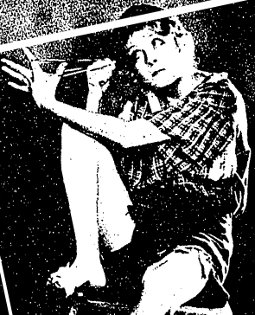
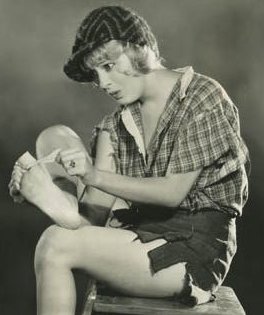
Notes
-
That I know of. When I started my research IMDb only listed eight, but I uncovered an additional appearance from a newspaper clipping. She was snapped performing in a chorus line in Alias Jimmy Valentine (“Chorus Time”). ↩
-
“First Car Crosses Span”. ↩
-
1920 US Census. ↩
-
“The Knees Have It”. ↩
-
“Floradora Sextette Has Rivals”. ↩
-
“Wife Declares”. ↩
-
“New Charges Added”. ↩
-
Patricia Schall, in a brief conversation via telephone. ↩
Bibliography
I owe a note of special thanks to Patricia Schall, Brinkman’s niece, who was kind enough to give me some leads on her aunt’s life.
-
Ancestry.com. 1910 United States Federal Census [database on-line]. Ancestry.com Operations Inc, 2006. Web. 31 May 2011 <http://search.ancestry.com/search/db.aspx?dbid=7884>.
-
Ancestry.com. 1920 United States Federal Census [database on-line]. Ancestry.com Operations Inc, 2010. Web. 31 May 2011 <http://search.ancestry.com/search/db.aspx?dbid=6061>.
-
Ancestry.com. California Voter Registrations, 1900-1968 [database on-line]. Ancestry.com Operations Inc, 2008. Web. 31 May 2011 <http://search.ancestry.com/search/db.aspx?dbid=1249>.
-
Ancestry.com. Social Security Death Index. Ancestry.com Operations Inc, 2011. Web. 6 June 2011 <http://ssdi.rootsweb.ancestry.com/>.
-
“Chorus Time”. Los Angeles Times 12 August 1928: I6. Print.
-
“Dolores Brinkman”. Arts and Vanities 17 September 1926: 33. Print.
-
“Dolores Brinkman”. IMDb. Web. 31 May 2011 <http://www.imdb.com/name/nm0109630/>
-
“Film Girl Solves Long-Hair Puzzle”. Los Angeles Times 8 March 1928: A2. Print.
-
“First Car Crosses Span”. Los Angeles Times 30 September 1928: G9. Print.
-
“Floradora Sextette Has Rivals”. Los Angeles Times 2 November 1927: A8. Print.
-
“The Knees Have It in This Case”. The Milwaukee Sentinel 19 December 1927: 18. Print.
-
The Mysterious Island. Dir. Lucien Hubbard. 1929. DVD.
-
“New Charges Added in Suit”. Los Angeles Times 31 July 1948: A3. Print.
-
Nye, Myra. “Society of Cinemaland”. Los Angeles Times 21 October 1928: B23. Print.
-
“Pretty Dolores Brinkman”. The Pittsburgh Press 3 June 1928: Photogravure Section 6. Print.
-
“Readin’, Ritin’ ‘N’ ‘Rithmetic Time”. Los Angeles Times 24 February 1929: I8. Print.
-
Whispering Whoopee. Dir. James W. Horne. 1930. DVD.
-
“Wife Declares Film Producer Loved Another”. Los Angeles Times 12 February 1949: 4. Print.
-
“Wife Divorces Mortuary Executive”. Los Angeles Times 6 August 1957: 16. Print.
-
“Wife in Move Against Head of Mortuary”. Los Angeles Times 14 September 1955: 26. Print.